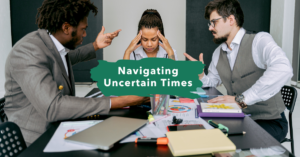It’s funny what you remember about past work experiences. We’ll spend (on average) 124,000 minutes per year working, which can add up to 5 million minutes over a lifetime. Most of those minutes are extraordinarily forgettable. Some are thankfully forgotten. Some are so mundane that they are a pale grey in your memory bank. Some are peak experiences that still provide an emotional jolt.
Some, however, are not the BIG moments but stay with us in a profoundly satisfying way. Many of those types of standout moments revolve around rituals.
I’m not talking about those scattered standout events, like graduations or annual holiday parties or retirement celebrations. Those are all wonderful but infrequent.
Today I’d like you to think about those day-to-day moments that stuck with you, that created a sense of connection with the work and with others, that still elicit fond memories and warm emotions.
I suspect that many of the workplace memories you hold that are meaningful and memorable involve a ritual.
For me, I vividly remember these things:
- My HR team and how we went to lunch every Thursday immediately after our team meeting
- A peer group that had a check-in ritual that welcomed everyone and set the tone for the rest of our time together
- My co-presenters for large events huddled with me pre-event, shoulder to shoulder, with all hands in the middle before taking the stage. We would share words of affirmation, look each other squarely in the eyes, and end with a loud cheer
- A very challenging team project where every Friday at 3 pm, a Flying Monkey fight let loose (more about this later)
I think you get the idea. These rituals are every day actions. They are not elaborate. And they matter.
Need some data? From Harvard Business School Researchers Michael Norton and Francesca Gino:
Performing a group bonding activity—regular rituals like doing the Walmart Cheer or firing a Nerf toy gun to conclude a project—led to a 16 percent increase in how meaningful employees judged their work to be, according to research by Harvard Business School Professor Michael Norton. Employees who engage in these rituals also tend to go the extra mile for the company, showing better “organizational citizenship” by doing things like staying late at work to help a colleague.
Such rituals don’t just boost morale. Companies reap huge benefits when workers feel their jobs have purpose; past research shows employees who view their work as meaningful are more motivated, happier, and more productive. Given these benefits, employers should consider experimenting with rituals as a way to bring employees closer together, whether in offices or in hybrid or remote environments, Norton says.
Research shows us that highly effective rituals have these three elements:
- They are PHYSICAL (you DO something)
- They are COMMUNAL (you DO something TOGETHER)
- They are PSYCHOLOGICAL (You DO Something TOGETHER that creates MEANING)
Huddling before going on stage with co-presenters is physical – we form a circle shoulder to shoulder with hands touching in the center. It is communal – everyone on the team involved with creating the event is there. It is psychological – it sets the tone, brings us together, and centers the energy we create together.
You might have recalled some of your own as you read through my list. After work drinks. Birthday celebrations. Funny rituals before sales calls. Team rituals at the beginning or end of team meetings.
Let’s unpack one of the silliest rituals I’ve been a part of: the flying monkeys. It is also one of the most memorable and one which I think exemplifies this concept.
 The work setting: The “war room” for a challenging ERP project with huge business implications, stringent deadlines, and mountains of work. Over the week, no less than thirty people were “heads down.” We came in early. We worked late. We sweated the deadlines and felt, more often than not, overwhelmed by the sheer amount that needed to be done.
The work setting: The “war room” for a challenging ERP project with huge business implications, stringent deadlines, and mountains of work. Over the week, no less than thirty people were “heads down.” We came in early. We worked late. We sweated the deadlines and felt, more often than not, overwhelmed by the sheer amount that needed to be done.
The Flying Monkey ritual: The “flying monkeys” were plush stuffed and caped monkeys that were actually a slingshot. As such, they could fly across the room, and hit a human target, and no harm was done. Even better, they made the most satisfying audible screech as they flew through the air.
During the week, the flying monkeys sat passively by, in desk drawers or hanging limply from cubicle dividers. Then at 4 pm on Fridays, someone would launch a monkey, and it would go screeching by toward its target, typically someone so engrossed in their work that they were visibly startled. Then another monkey would fly by, and then another and yet another. Soon monkeys were flying by, and there was a palatable shift in the room’s mood as laughter, playful taunts, and vows of revenge filled the air.
Clearly, this ritual was physical (ask anyone who was being bombarded by a flying monkey) and communal (if you were there, you played). The more interesting aspect was the psychological. Here is what I observed:
- This simple ritual bonded the team in a game of silliness. It put some lightness in a very heavy task.
- It brought even the most introverted “coder” into a safe space to interact with the bigger team.
- It provided perspective – our work was heavy, but our lives didn’t need to be.
- It signaled the transition from work week to weekend. It provided a tangible signal that it was time to power down the PC, release the stress of the week, and leave all that at work.
But What About Hybrid or Remote Workplaces?
Flying monkeys and lunches and team huddles are all wonderful – and all depend on one of the three elements of successful rituals: physicality. This leaves us in a conundrum with virtual and remote teams.
I suspect you, as well as me, have been part of valiant, yet vexing, attempts to create ritual and connection virtually. I’ve been part of people hoisting drinks on Zoom. Of online scavenger hunts. Of Zoom coffee breaks.
Some are more effective than others. I’m part of a community of senior consultants who meet weekly in a “virtual coffee shop.” There is a trained barista that hosts the coffee shop. There is a discussion topic. People drop in when they can and for how often they can. Some stay for the two hours the coffee shop is open, and some visit for a short 10 minutes. Repeated week after week, it has become a ritual that we look forward to and know that there is always a place to come for camaraderie, support, and good conversation.
Others are just plain dismal. For example, I was part of a 30-minute professional networking meeting in which the two moderators were the only ones that shared the microphone the entire time. Instead of feeling connected and engaged, I was frustrated and vowed never to return to this group.
As such, my recommendation on rituals for virtual or remote teams is this:
We need to be even more intentional about creating connections and community
with remote teams than we are with co-located teams.
Let me be clear; I’m not all that convinced that we do a stellar job of creating connections and community in a traditional work setting. Many of the rituals I described earlier were less intentional and more serendipitous. That suggests that we CAN be more intentional (I’m not talking “forced fun”) and, as a result, be more effective.
Best practice is showing that remote teams do need to come together physically regularly. Gatherings may be monthly (if the travel is more accessible) or semi-annually (if the team is far-flung). No matter, the need is real, and the impetuous for leaders is to plan for in-person gatherings with both a purpose and a plan that create connections and build rituals. The meeting itself can become a ritual. You can also use that time to envision and create some other rituals that the team carries on over time and distance.
This is only one of the reasons why I’m so excited to offer four different retreats for four different purposes:
The Reset Retreat – to renew, refresh and refocus. Create a team ritual of mindfulness!
The Higher Purpose – to define purpose, create unity, and ignite passion. Create a team ritual of seeking the greater good.
The Harmonic Team – to build trust, teamwork and build relationships. Create a team ritual designed for your team/by your team.
The Questions Only – To explore, create and empower. Create a team ritual of consistently asking great questions.
Want to learn more?
Learn more about Evergreen Leadership retreats here.
Here is the HBR article on the value of rituals.




